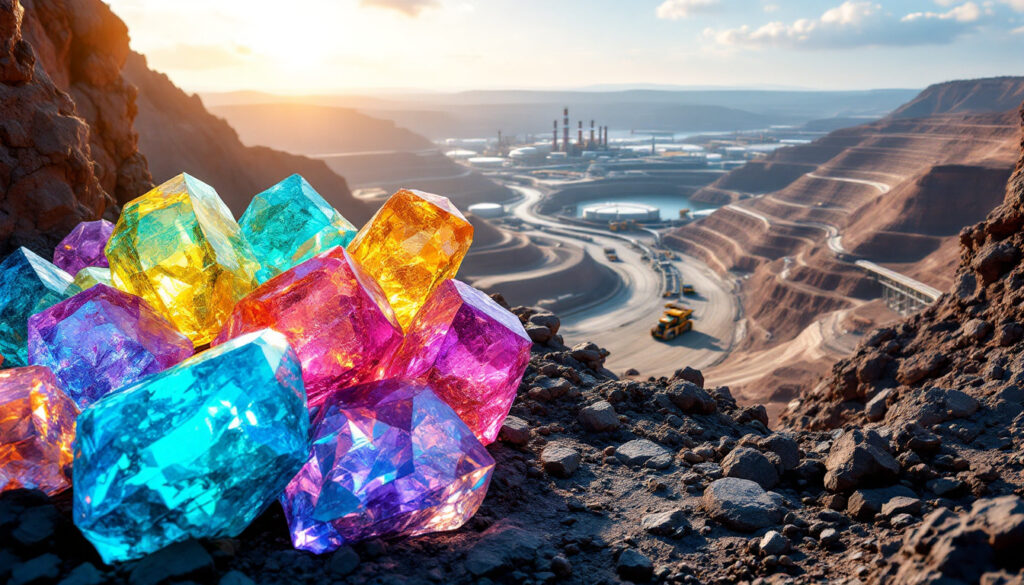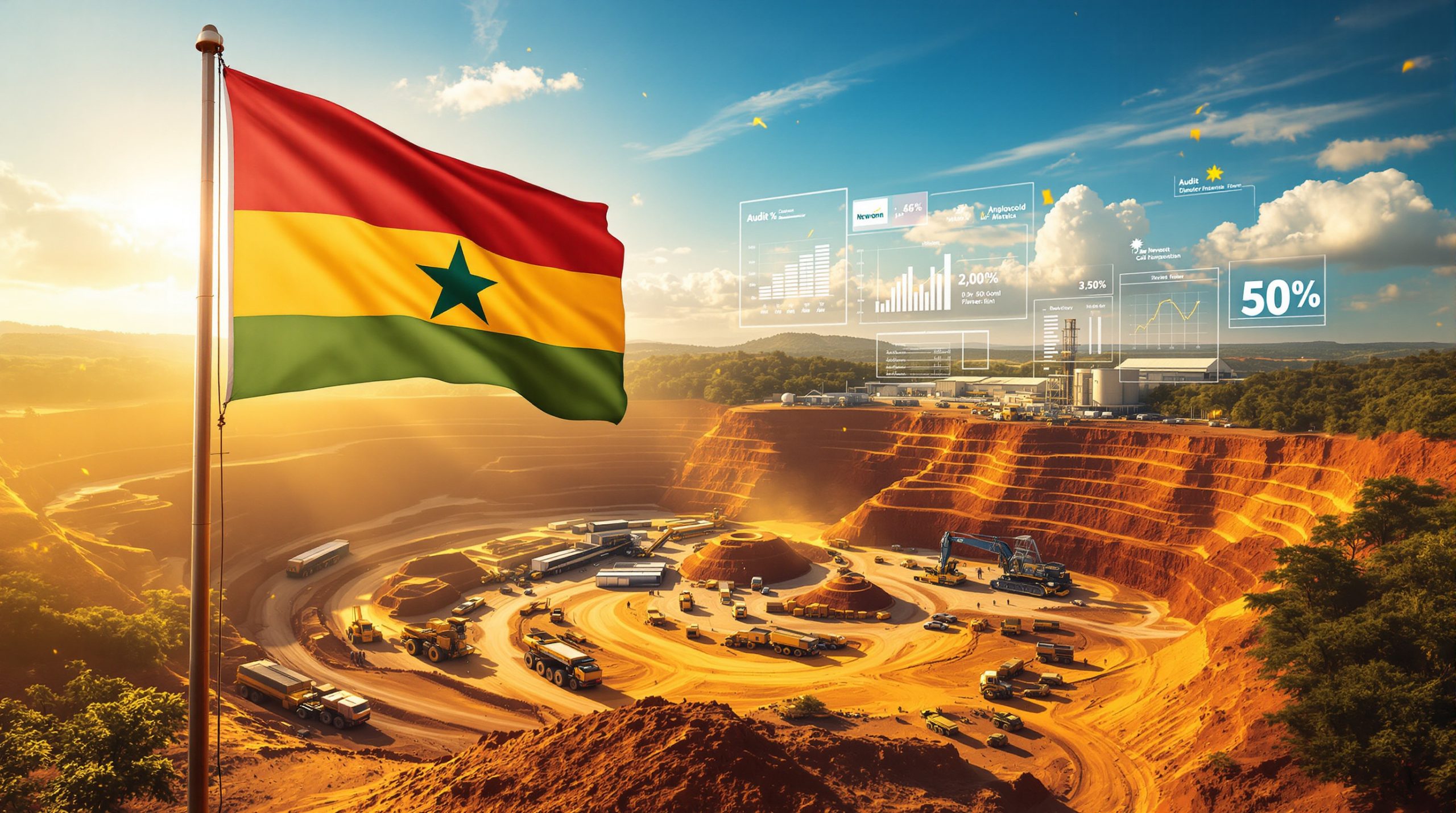Rio Tinto's Strategic Pivot to Rare Earth Elements: Meeting Critical Mineral Demands
In an era of increasing technological advancement and energy transition, mining giant Rio Tinto is strategically positioning itself in the rare earths and critical minerals market. This move represents not just an opportunity for diversification but a response to changing global demands and geopolitical shifts in mineral security. While maintaining its traditional focus on iron ore, aluminum, and copper, Rio's venture into scandium and potential gallium production signals a new direction for one of the world's largest miners.
What Are Rio Tinto's Plans for Rare Earth Elements?
Rio Tinto has begun establishing itself in the rare earth elements (REE) market, currently focusing on scandium production while exploring possibilities for gallium. Unlike some competitors pursuing aggressive acquisition strategies, Rio's approach is distinctly measured and demand-driven.
"We will only expand into rare earths if demand is clear," stated CEO Jacob Stausholm in a recent industry briefing, highlighting the company's pragmatic approach to this growing sector.
Current Rare Earth Operations and Future Potential
Rio Tinto has successfully integrated scandium production into its existing operations, leveraging its technological expertise to extract this valuable element. Scandium, though produced in relatively small quantities, commands premium pricing due to its applications in:
- Aerospace alloys – Creating stronger, more corrosion-resistant materials
- Solid oxide fuel cells – Enhancing electrical conductivity and performance
- Sports equipment – Providing lightweight strength for high-performance gear
The company is also evaluating gallium production, which would complement its existing operations. Gallium has become increasingly critical for:
- Semiconductor manufacturing
- LED production
- 5G telecommunications infrastructure
- Solar panel production
This strategic positioning allows Rio Tinto to capitalize on growing demand for materials essential to technological advancement while utilizing existing operational frameworks.
How Critical Minerals Fit Into Rio's Broader Strategy
While critical minerals operations remain relatively small compared to Rio's core business segments, Chairman Dominic Barton has emphasized their strategic importance, noting they could "boost Rio's social license and supply chain resilience" in an increasingly volatile global market.
The critical minerals strategy serves multiple objectives:
- Portfolio diversification – Reducing dependency on traditional commodities
- ESG enhancement – Supporting clean energy technologies and sustainability goals
- Market positioning – Establishing presence in high-growth sectors
- Supply chain security – Providing Western markets with alternatives to Chinese supply dominance
"Critical minerals represent not just a business opportunity but a strategic imperative as global supply chains realign," noted Barton during Rio's annual general meeting.
Though relatively modest in scale compared to iron ore or aluminum, these operations position Rio Tinto advantageously in a world increasingly focused on mineral security and technological sovereignty.
Why Is Rio Tinto Exploring Critical Minerals Now?
The timing of Rio Tinto's critical minerals push coincides with multiple global factors creating favorable market conditions. The convergence of geopolitical tensions, energy transition demands, and technological evolution has created a perfect storm for critical minerals race.
Global Trade Tensions Creating New Market Dynamics
International trade relations, particularly between China and Western nations, have fundamentally altered the critical minerals landscape. With China controlling approximately 80% of global rare earth processing capacity, Western governments and companies are actively seeking supply alternatives.
Recent developments include:
- Targeted tariffs on strategic minerals like gallium and germanium
- Export restrictions from major producing countries
- Reshoring initiatives to secure domestic supply chains
- Strategic partnerships between mining companies and technology manufacturers
Rio Tinto's existing operations in politically stable jurisdictions like Australia, Canada, and the United States provide significant advantages in this shifting landscape. The company can navigate tariff structures more effectively than competitors with heavier exposure to politically sensitive regions.
Energy Transition Driving Demand for Specialized Materials
The global push toward renewable energy and electrification has dramatically increased demand for critical minerals. CEO Stausholm has acknowledged that the energy transition is "reshaping the market" for minerals previously considered niche.
Market projections support this strategic direction:
- The global critical minerals market is projected to grow at approximately 12% CAGR between 2023 and 2030
- Demand for rare earth magnets, essential for wind turbines and electric vehicles, is expected to double by 2030
- Scandium-aluminum alloys could capture significant market share in next-generation transportation applications
Rio Tinto's gradual entry into this space represents a calculated response to these trends, focusing on elements where they have technological advantages and existing operational synergies.
How Does This Strategy Connect to Rio's Copper Ambitions?
Rio Tinto's critical minerals strategy complements its broader focus on copper, which remains central to the company's future growth plans. Both strategies align with the global electrification trend, creating operational and copper market dynamics.
Progress on U.S. Copper Projects
Rio Tinto has expressed optimism about its U.S. copper projects, which are progressing despite regulatory challenges. These operations represent a crucial component of the company's strategy to support domestic supply chains in North America.
Key developments include:
- Resolution Copper (Arizona) – Advancing through permitting processes despite indigenous land use controversies
- Kennecott Operations (Utah) – Implementing technological improvements to extend mine life and increase recovery rates
- Exploration Activities – Continuing across the American Southwest with focus on high-grade deposits
These projects stand in stark contrast to competitor Glencore, which recently reported a 30% decline in copper production during the first quarter of 2024, leading to an 8% drop in share price.
Simandou Project Development in West Africa
Beyond North America, Rio Tinto's Simandou iron ore project in Guinea has significant strategic implications. With estimated reserves of over 2 billion tons of high-grade iron ore, this project represents one of the world's largest untapped resources.
The development timeline includes:
- Continuing infrastructure development throughout 2024
- Environmental approvals expected by early 2025
- Initial production targeted for late 2025
- Full capacity operations anticipated by 2028
While primarily an iron ore project, Simandou illustrates Rio Tinto's approach to resource development in challenging jurisdictions—experience that will prove valuable as the company expands its critical minerals footprint.
What Corporate Governance Issues Is Rio Tinto Addressing?
Rio Tinto's governance structure has faced increased scrutiny as it navigates these strategic shifts, with shareholders pushing for greater transparency and operational efficiency.
Recent Shareholder Proposals and Voting Outcomes
At Rio Tinto's most recent annual general meeting, proposals calling for a structural review of the company garnered 19% shareholder support—a significant minority that management cannot easily dismiss. These proposals centered on:
- Evaluating the efficiency of Rio's dual-listed company structure
- Assessing organizational alignment with strategic priorities
- Reviewing capital allocation frameworks across diverse commodity segments
- Strengthening ESG oversight and implementation
While management hasn't explicitly rejected these proposals, their response has emphasized gradual evolution rather than radical restructuring.
Leadership Vision for Critical Minerals
The current leadership team, headed by CEO Jacob Stausholm and Chairman Dominic Barton, has articulated a coherent vision for critical minerals integration that balances opportunity with pragmatism.
Stausholm's background in finance and Barton's experience in global consulting have shaped a strategic approach characterized by:
- Demand-driven expansion – Moving only when market signals are clear
- Technological leverage – Utilizing existing expertise in extraction and processing
- Portfolio optimization – Ensuring new ventures complement core operations
- Capital discipline – Maintaining rigorous investment criteria even in high-growth sectors
This measured approach contrasts with some competitors who have made larger, more speculative investments in the critical minerals space.
How Does Rio Tinto Compare to Other Mining Giants in the Critical Minerals Space?
The critical minerals landscape features diverse approaches from major mining companies, with Rio Tinto's strategy differing notably from peers like Glencore, BHP, and Anglo American.
Competitive Positioning Against Glencore
Glencore and Rio Tinto represent contrasting approaches to resource portfolio management:
| Aspect | Rio Tinto | Glencore |
|---|---|---|
| Critical Minerals Strategy | Selective, demand-driven development | Aggressive cobalt and nickel focus |
| Production Trends | Stable, incremental growth | Volatile (30% copper decline, 44% cobalt increase) |
| Market Valuation | Relatively stable | Declined to $40B (from $90B peak) |
| Acquisition Approach | Organic development preferred | More acquisition-focused |
| Governance Model | Dual-listed structure | Unified listing |
Glencore's recent production challenges highlight the benefits of Rio Tinto's more measured approach, particularly in volatile commodity markets.
Industry-Wide Trends in Critical Minerals Investment
Across the mining sector, companies are adjusting strategies to address critical mineral shortages:
- BHP has divested nickel assets while increasing copper focus
- Anglo American has defended against hostile takeover partly on critical minerals potential
- Fortescue Metals has aggressively entered green hydrogen and battery metals
- The Metals Company is pursuing controversial deep-sea nodule mining in the Clarion-Clipperton Zone
Rio Tinto's approach sits between the conservative stance of BHP and the more aggressive positions of newer entrants, balancing opportunity with risk management.
What Global Developments Are Shaping the Critical Minerals Market?
Government initiatives worldwide are reshaping the critical minerals landscape, creating both opportunities and regulatory complexities for mining companies.
U.S.-Ukraine Minerals Agreement Impact
A recent minerals agreement between the United States and Ukraine has significant implications for global supply chains. The deal provides:
- Priority access for U.S. companies to Ukrainian mineral resources
- Technical assistance for developing Ukraine's extraction capabilities
- Funding mechanisms through a reconstruction fund
- Regulatory cooperation to streamline approval processes
Former President Trump characterized the agreement as one that "deters bad actors" in the critical minerals space, highlighting the geopolitical dimensions of resource development.
This agreement potentially creates new partnership opportunities for Western mining companies with existing technological expertise.
European Union's Critical Raw Materials Strategy
The European Union's Critical Raw Materials Act (CRMA) represents another significant policy development, designating minerals like lithium as strategically essential and supporting domestic production.
Key elements include:
- €36 million grant to the Czech Cinovec lithium project
- Target of 10% self-sufficiency in lithium by 2030
- Streamlined permitting for strategic mineral projects
- Support for recycling and circular economy initiatives
The Cinovec project aims to produce approximately 25,000 tonnes of lithium carbonate annually, significantly reducing European dependency on imported materials.
For Rio Tinto, these policy developments create potential partnership opportunities while also establishing more predictable regulatory frameworks for future investments.
What Are the Emerging Controversies in Critical Minerals Sourcing?
As demand for critical minerals increases, so do controversies surrounding their extraction, particularly regarding environmental impact and regulatory jurisdiction.
Deep-Sea Mining Regulatory Challenges
The emerging deep-sea mining sector highlights the complex interplay between resource needs and environmental protection:
- The Metals Company has submitted an application for Pacific Ocean mining rights, currently under 60-day U.S. review
- Potential jurisdictional conflicts exist between U.S. regulations and the International Seabed Authority
- Small Pacific nations like Tonga and Nauru have granted exploration licenses, raising sovereignty questions
- Environmental groups warn of "irreversible ecosystem damage" from seabed disruption
This regulatory uncertainty creates both risk and opportunity for established miners like Rio Tinto, which could either enter the space once rules are clarified or benefit from restricted supply if regulations limit seabed mining.
Balancing Environmental Impact with Supply Security
The extractive industry faces growing scrutiny regarding environmental practices, particularly for critical minerals with complex processing requirements:
- Rare earth processing traditionally involves significant chemical usage and waste management challenges
- Water consumption concerns in lithium brine operations have sparked community opposition
- Carbon footprint of mineral processing is increasingly subject to investor and regulatory scrutiny
- Indigenous land rights conflicts have delayed projects globally
Rio Tinto's approach emphasizes technological solutions to these challenges, investing in research to reduce mining decarbonisation efforts while maintaining commercial viability.
What Should Investors Know About Critical Minerals Markets?
For investors evaluating Rio Tinto's critical minerals strategy, several factors merit consideration when assessing long-term value creation potential.
Production Challenges and Market Volatility
Recent industry experiences highlight the operational challenges facing critical minerals producers:
- Glencore's 30% copper production decline in Q1 2024 led to an 8% share price drop
- Market analysts attribute such volatility to "grade variability" in aging mines
- Nickel prices dropped 21% in 2023 despite projected long-term demand growth
- Processing bottlenecks continue to constrain rare earth supply chain expansion
These challenges underscore the importance of Rio Tinto's measured approach, focusing on operational excellence before aggressive expansion.
Investment Outlook for Rare Earths and Critical Minerals
The investment case for critical minerals combines long-term structural growth with near-term rare earth market volatility:
"The critical minerals market will likely experience supply-demand mismatches for years to come, creating both price volatility and strategic opportunity," noted a recent Wood Mackenzie analysis.
Key considerations for investors include:
- Timeframes – Returns will likely materialize over 5-10 year horizons rather than quarterly cycles
- Policy dependency – Government initiatives significantly impact project economics
- Technology risk – Material substitution can disrupt demand projections
- Integration value – Companies with mine-to-market capabilities may capture premium valuations
For Rio Tinto specifically, the critical minerals strategy represents a relatively low-risk approach to portfolio diversification that leverages existing capabilities while positioning for future growth.
FAQ: Rio Tinto and Rare Earth Elements
What rare earth elements is Rio Tinto currently producing?
Rio Tinto is currently producing scandium and considering expansion into gallium production. The company focuses on critical minerals that complement their existing operations and meet clear market demand rather than pursuing the full spectrum of rare earth elements. Their selective approach differs from competitors pursuing more comprehensive rare earth portfolios.
How significant are critical minerals to Rio Tinto's overall business?
While critical minerals operations remain relatively small in scale compared to Rio's core businesses of iron ore, aluminum, and copper, they offer strategic advantages in enhancing social license and strengthening supply chain resilience. Chairman Dominic Barton has emphasized their importance for long-term positioning rather than immediate revenue contribution.
What factors will determine Rio Tinto's further expansion into rare earths?
CEO Jacob Stausholm has clearly indicated that market demand will be the primary driver for expansion decisions. The company will only increase investment when offtake agreements and pricing signals confirm commercial viability. This demand-driven approach aims to avoid the boom-bust cycles that have historically characterized the rare earths market.
How does Rio Tinto's approach to critical minerals compare to other major miners?
Unlike some competitors pursuing aggressive expansion through acquisitions, Rio Tinto is taking a measured, organic growth approach to critical minerals. This strategy focuses on leveraging existing technological expertise and operational footprints rather than large-scale acquisitions. The contrast with Glencore's volatile production profile highlights the benefits of Rio's more gradual approach, as Brazilian Rare Earths' recent agreement with the company demonstrates.
Want to Capitalise on the Next Major Mineral Discovery?
Stay ahead of the market with Discovery Alert's proprietary Discovery IQ model, which instantly notifies investors of significant ASX mineral discoveries and transforms complex data into actionable insights for both short-term trading and long-term investment opportunities. Visit the Discovery Alert discoveries page to understand how historic mineral discoveries have generated substantial returns for early investors.




